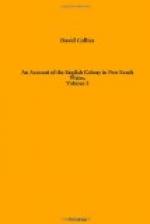If a corresponding height of similar strata was observable on the islands and on the main, it would amount to a proof that they were originally connected; but this proof was wanting. The same kind of strata appeared in both; but, as far as could be determined in passing hastily by, the necessary correspondence seemed to be deficient. They did not land upon either the islands or the main; but two kinds of rock, one with strata and the other without, were plainly discernible. That without strata formed by far the largest part; it appeared whitish and shining, was certainly a quartz, and probably a granite. The layers of the rock with strata were of various dark colours, and perfectly distinct.
It was evident, that land so much exposed to the violence of extensive oceans must have undergone some very material changes, by the incessant attrition of their vast waves. Two of the isles, either from this or a more sudden cause, have so far deviated from their centre, that their parallel strata form angles of between sixteens and eighteen degrees in one instance, and in another between twenty-five and thirty degrees, with the horizontal line. But it is difficult to explain, by the action of water, how a large block of the white stone without strata is caused to overhang an almost perpendicular corner of one of the islands, which beneath that block consists of the dark coloured stone lying in strata.
De Witt’s Isles, (so named, probably, by Tasman) twelve in number, are of various sizes. The two largest are from three to four miles in circuit. Their sides are steep, but their height is inferior to that of the main. The largest is the lowest. The smaller isles are little more than large lumps of rock, of which that named by Captain Cook the mew stone is the southernmost. Their aspect, like that of the main, bespeaks extreme sterility; but, superior to the greater part of it, they produce a continued covering of brush; and upon the sloping sides of some of their gullies are a few stinted, half dead gum trees.
They could not account for the vestiges of fires that appeared upon the two inner large islands; the innermost in particular, which lay at some distance from the nearest point of the main, was burnt in patches upon different parts of it. It must have been effected either by lightning, or by the hand of man; but it was so much unlike the usual effects of the former, that, with all its difficulties, they chose to attribute it to the latter cause.




